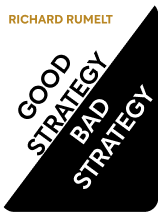

This article is an excerpt from the Shortform book guide to "Good Strategy Bad Strategy" by Richard Rumelt. Shortform has the world's best summaries and analyses of books you should be reading.
Like this article? Sign up for a free trial here .
What is a business competitive advantage? What are some examples of competitive advantage in real-world business?
In business, a competitive advantage is any attribute that allows you to perform better than your competitors. This usually occurs because they cannot replicate the resources underpinning it. So for example, a solid patent, a long-standing reputation for quality, or an outsized economy of scale will all give a company an advantage that is hard for a rival to overcome.
Keep reading to learn about the different ways a company can exercise its competitive advantage in business.
The Power of a Sustained Competitive Advantage in Business
Long-term success relies on having a sustained competitive advantage. This phrase has two parts: competitive and sustained. An advantage is competitive when you do something better than your rivals. An advantage is sustained when your competitors cannot replicate it.
Sustaining a business competitive advantage in business often means adjusting it or finding new ways to apply it as your industry evolves. A competitive advantage is only financially valuable if a leader can figure out how to increase its value against changing market conditions. A company with a competitive advantage that doesn’t change with the changing business landscape might end up trundling along slightly profitable but never realizing the full potential of its competitive edge.
For example, eBay has a competitive advantage as a platform providing the most efficient way to buy or sell a personal item online, and it has a broad customer base, a state-of-the-art payment system, and a rating system that sets it apart from competitors. However, its market value has steadily declined for many years. The company must figure out a way to harness and leverage its competitive advantage in order to create financial value from it.
There are four ways a company can try to press its business competitive advantage in response to changing conditions. It can:
- Increase its advantage.
- Broaden its advantage.
- Increase demand for its advantage.
- Limit its rivals’ ability to replicate its advantage.
Each of these approaches is explored in the sections below.
Increase Your Advantage
One way to define an advantage is the difference between what it costs you to produce a product or provide a service and how much a customer values that product or service. Increasing an advantage means either reducing its costs or increasing its value to customers, or both. To reduce costs, examine every aspect of how your operations work and reevaluate processes you might be taking for granted. To increase customer value, study your customers and develop empathy for them that allows you to understand their attitudes, values, and desires.
An example of finding novel ways to decrease costs through keen observation is when Frank Gilbreth revolutionized the process of bricklaying in the early 1900s. Bricklayers had, for centuries, worked in the same way, but Gilbreth carefully studied the process and realized he could more than double productivity by simply adjusting some of the procedures: placing brick pallets closer to chest-height and improving mortar consistency. In doing so, he decreased his production costs (the time needed to lay bricks) and accordingly, his competitive advantage increased.
Broaden Your Advantage
Broadening an advantage means applying it to new fields and new competitors. To successfully do this you must focus on what skills and resources underpin a particular advantage, instead of the specific products, buyers, and competitors that are linked to it.
It’s important to focus on skills and resources because if a company thinks of itself in terms of a product instead of in terms of the skills it uses to bring that product to market, it might expand into fields it knows nothing about because the skills required for success are different. For example, in the above case study of Crown Cork & Seal, when they eventually expanded into plastics, they did so because they pinned their advantage as a producer of containers rather than their true advantage as a producer of high-end, tailored production runs.
An example of a company effectively broadening its advantage is DuPont, which started as an explosives company and leveraged its expertise in chemistry (its skill set) to ultimately manufacture plastics and other synthetics for household consumer use. Instead of simply chasing the explosives industry, they looked at what other uses they could put their skills to.
Increase Demand for Your Advantage
Another way you can press your advantage is to increase demand for your product or service. There are two ways to increase demand: either increase the number of buyers or increase the amount each buyer demands. Then, you must be sure that you are positioned to take advantage of this new demand in a way that your competitors are not.
An excellent example of this process comes from the previously mentioned Roll International. In addition to nuts and citrus, the company also invested in pomegranate orchards and created the POM Wonderful company. When it planted its orchards, pomegranates were a somewhat exotic fruit with a small market. In fact, Roll’s investment alone increased U.S. production of pomegranates sixfold. However, the company saw potential where no one else had, and it implemented an aggressive marketing campaign to educate consumers on the health benefits of pomegranate juice. By the time the crop was ready for market, the company had created a new beverage category to receive it.
Limit Rivals’ Ability to Replicate Your Advantage
One more way you can press your advantage is to limit your competition’s ability to replicate it. Companies do this all the time when they extend patents and defend trademarks, leveraging legal protections to limit competition.
Companies also do this by constantly innovating, making their products or services into moving targets that are difficult for competitors to duplicate before they’ve improved again. For example, Microsoft is constantly upgrading and evolving its Windows operating system, consistently raising the bar for any potential imitators.
Case Study: Roll International Corporation
Roll International is an excellent example of how to effectively press your advantages and maintain a sustained competitive advantage. It became a leading agricultural producer by using its size as leverage to create a competitive edge that rivals couldn’t match.
Founders Stewart and Lynda Resnick began to invest in agribusiness in the 1980s with citrus and nuts. They purchased enough land to take advantage of economies of scale and then, to press that advantage, they began a marketing campaign extolling the health benefits of their products, essentially creating demand for them where there had been little. Although growth in demand would benefit all nut and pomegranate farmers, since Roll was the largest producer, it reaped the most benefits. The company was also able to leverage economies of scale because of its size, which it used to more efficiently process and package its goods.
Because agriculture is an industry that inherently changes slowly, limited by the growth of orchards, Roll was able to get ahead of competitors by positioning itself to benefit from this anticipated demand before its competitors became aware of its potential. For its competitors to catch up, they’d have to purchase new land and plant new orchards, as well as invest in processing facilities, marketing, packaging, and distribution. Because Roll had an early start and an asymmetrical (larger) size, the company had a competitive advantage that its competitors could not replicate. Today it is an industry-leading grower of citrus and nuts.

———End of Preview———
Like what you just read? Read the rest of the world's best book summary and analysis of Richard Rumelt's "Good Strategy Bad Strategy" at Shortform .
Here's what you'll find in our full Good Strategy Bad Strategy summary :
- The essential components of good strategy and the faulty thinking behind bad strategy
- Specific and measurable techniques for designing a focused strategy for success
- How to overcome challenges and gain a competitive edge






